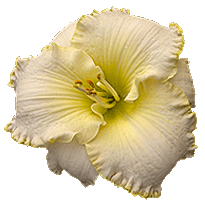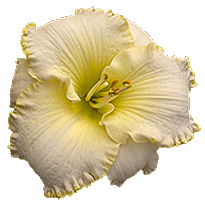




The terms "evergreen," “semi-evergreen," and "dormant" are often misinterpreted as relating to the winter hardiness of a daylily. In fact, they do not relate to the winter hardiness at all. A given daylily may belong to any one of these classifications and be hardy or not in a given climatic zone.
These terms loosely characterize the behavior of daylilies during the winter months. Just as with trees, shrubs, and other perennials, “evergreens” retain their foliage color throughout the winter. "Dormant" is virtually synonymous with "deciduous" and applies to those daylilies whose foliage completely dies off for the winter. "Semi-evergreen" is a catch-all term that applies to those daylilies whose foliage in the winter can best be described as somewhere between evergreen and dormant; the foliage dies back, but not all the way; there is still some degree of green left in the leaves.
While one or the other of these three terms may have been used in the description of a particular daylily, the plant may not behave that way in your garden. For instance: a daylily that is evergreen in one climatic zone may go completely dormant in another and vice-versa. In other words, whether a daylily is evergreen, semi-evergreen, or dormant depends not only on the particular daylily cultivar, but also on the climatic zone in which it is being grown. Here in our gardens in Zone 5, we have a number of daylilies that, when purchased, were labeled "evergreen." Looking across the daylily beds in mid-winter, I fail to see any one of them looking evergreen; at best they have a bit of green left in their leaves, much like a semi-evergreen.
Come spring, however, when the daylilies begin their new growth, it easy to tell the dormants on the one hand from the evergreens and semi-evergreens on the other. Because the foliage of the dormants will have died off completely during the winter, their new leaves emerge in unscathed condition. Since the leaves of the evergreens and semi-evergreens did not die off completely during the winter, they have been exposed to the freezing cold. Their new growth, therefore, has leaves that have been damaged to some extent or other, usually looking pale green-yellow at the tips or for several inches down the leaf.
The bottom line: It really doesn't matter how the daylily is labeled with any one of these terms. The issue is winter hardiness. Maybe in warmer USDA climate zones, like 8 and 9+ this is an important issue because it will predict what the daylily will look like in the winter, but here in Zone 5, even the "evergreens" look pretty dead in the midst of winter!
Back to - Daylily Article Index
For Reference - Glossary of Daylily Terms

| Home Page | Our Daylilies | Daylily Cultivation Article Index |
| Information Center | Site Map | Offsite Links |
Internet Explorer 5+
Mozilla Firefox 2+
(You can download either of the browsers listed above by clicking on their name link)







